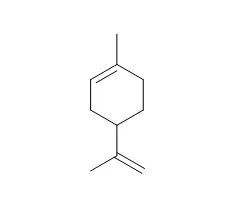| In vitro: |
| Food Chem Toxicol. 2015 Jul;81:160-70. | | The antioxidant and antigenotoxic properties of citrus phenolics limonene and naringin.[Pubmed: 25896273] | Phenolic compounds not only contribute to the sensory qualities of fruits and vegetables but also exhibit several health protective properties. Limonene and naringin are the most popular phenolics found in Citrus plants.
METHODS AND RESULTS:
In this study, we investigated the antioxidant capacities of Limonene and naringin by the trolox equivalent antioxidant capacity (TEAC) assay and the cytotoxic effects by 3-(4,5-Dimethylthiazol-2-yl)-2,5-diphenyltetrazolium bromide (MTT) assay in Chinese hamster fibroblast (V79) cells. The genotoxic potentials of Limonene and naringin were evaluated by micronucleus (MN) and alkaline COMET assays in human lymphocytes and V79 cells. Limonene and naringin, were found to have antioxidant activities at concentrations of 2-2000 µM and 5-2000 µM respectively. IC50 values of Limonene and naringin were found to be 1265 µM and 9026 µM, respectively. Limonene at the concentrations below 10,000 µM and naringin at the all concentrations studied, have not exerted genotoxic effects in lymphocytes and in V79 cells.
CONCLUSIONS:
Limonene and naringin at all concentrations revealed a reduction in the frequency of MN and DNA damage induced by H2O2. | | Phytomedicine . 2019 Feb;53:37-42. | | Gastroprotective effect of limonene in rats: Influence on oxidative stress, inflammation and gene expression[Pubmed: 30668410] | | Abstract
Background: In an increasing search for natural products that may heal the ulcers and avoid its recurrence, Limonene appears as a promising candidate.
Hypothesis/purpose: The present study aimed to investigate the protective effect of Limonene in ethanol-induced gastric ulcers, in addition, to investigate the involvement of antioxidant and anti-inflammatory activities, besides the modulation of gene expression.
Study design: Male Wistar rats were orally treated with vehicle (8% tween 80), carbenoxolone (100 mg/kg) or Limonene (25, 50 or 100 mg/kg) and then orally received ethanol to induce gastric ulcers formation.
Methods: The activity of myeloperoxidase (MPO) was measured. Levels of glutathione (GSH) and activities of glutathione peroxidase (GPx), glutathione reductase (GR) and superoxide dismutase (SOD) were measured. We investigated the anti-inflammatory effect of Limonene measuring the levels of pro-inflammatory cytokines tumor necrosis factor-a (TNF-a), interleukin-6 (IL-6), interleukin-1β (IL-1β) and anti-inflammatory cytokine interleukin-10 (IL-10) by ELISA. Additionally, we investigate through real-time PCR (qPCR) the gene expression of nuclear factor-kappa B (Nf-κb), Gpx, Il-1β, Mpo, and Il-10.
Results: Our results showed that Limonene 50 mg/kg was the lowest effective dose, offering 93% of reduction in gastric ulcer area compared with the vehicle. There was an increase in mucus production and higher preservation of gastric mucosa integrity after treatment with Limonene.There was a reduction in the MPO activity, a biomarker of neutrophils infiltration, and an increase in GPx activity, suggesting an antioxidant effect. Limonene displayed anti-inflammatory activity through decreasing the levels of TNF-a, IL-6, and IL-1β and increasing the level of IL-10. Limonene could down-regulate the expression of Nf-κb, Il-1β, and Mpo and up-regulate the expression of Gpx.
Conclusion: Our results demonstrate that oral treatment with Limonene exerts gastroprotection through local mucosal defense mechanisms, such as increasing the mucus production, modulation of the oxidative stress and inflammatory response and inhibition of Nf-κb expression.
Keywords: Antioxidant; Gastric ulcer; Gene expression; Inflammation; Limonene; qPCR. |
|






 Cell. 2018 Jan 11;172(1-2):249-261.e12. doi: 10.1016/j.cell.2017.12.019.IF=36.216(2019)
Cell. 2018 Jan 11;172(1-2):249-261.e12. doi: 10.1016/j.cell.2017.12.019.IF=36.216(2019) Cell Metab. 2020 Mar 3;31(3):534-548.e5. doi: 10.1016/j.cmet.2020.01.002.IF=22.415(2019)
Cell Metab. 2020 Mar 3;31(3):534-548.e5. doi: 10.1016/j.cmet.2020.01.002.IF=22.415(2019) Mol Cell. 2017 Nov 16;68(4):673-685.e6. doi: 10.1016/j.molcel.2017.10.022.IF=14.548(2019)
Mol Cell. 2017 Nov 16;68(4):673-685.e6. doi: 10.1016/j.molcel.2017.10.022.IF=14.548(2019)